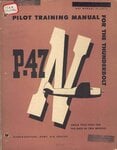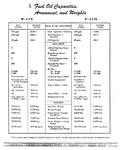Navigation
Install the app
How to install the app on iOS
Follow along with the video below to see how to install our site as a web app on your home screen.
Note: This feature may not be available in some browsers.
More options
You are using an out of date browser. It may not display this or other websites correctly.
You should upgrade or use an alternative browser.
You should upgrade or use an alternative browser.
Grumman F8F Bearcat or P-47?
- Thread starter I3unZss
- Start date
Ad: This forum contains affiliate links to products on Amazon and eBay. More information in Terms and rules
More options
Who Replied?John D. Voss
Airman
- 59
- Aug 10, 2016
I always thought of the F8F Bearcat to be a fighter aircraft and as a direct replacement for the F6F Hellcat.
P-47 by a landmile - twice the gun firepower, greater loiter time and combat radius (far greater with P-47N in equation), can combine greater weight of bombs & rockets in the same time, far better G loading limit (useful for coming out from dive bomb at great speed). But It's greatest attribute was that it was actually available in ww2.
Vic Nighthorse
Airman
- 34
- Sep 9, 2018
Are you saying that you think 8 .50 M2s have twice the effectiveness of 4 20mm M3s? The thread author doesn't specify a time so I don't think one not existing in WWII necessarily matters. That one was designed to be flown off a carrier might make it more practical in some circumstances as well, no? I'd say the comparison has far too little context to be satisfactorily addressed. I recognize that you make a lot of contributions to this forum, have more knowledge on the subject than I, and I am not criticizing you.P-47 by a landmile - twice the gun firepower, .
Last edited:
Are you saying that you think 8 .50 M2s have twice the effectiveness of 4 20mm M3s? The thread author doesn't specify a time so I don't think one not existing in WWII necessarily matters. That one could also be flown off a carrier might make it more practical in some circumstances as well, no? I'd say the comparison has far too little context to be satisfactory addressed. I recognize that you make a lot of contributions to this forum, have more knowledge on the subject than I, and I am not criticizing you.
No problems, man
BTW - seems like the F8F was using M2 machine guns, per this discussion :link
GreenKnight121
Senior Airman
- 598
- Mar 16, 2014
The F8F-1 (769 built) had 4x Browning M2 .50cal guns with 325 rounds per gun for the inboard guns & 200 rounds per gun for the outboard guns.
The F8F-1B (226 built), F8F-2 (365 built) and the night-fighter & photo-recon variants used the AN/M3 20mm cannon with 225 rounds per gun for the inboard guns & 188 rounds per gun for the outboard guns.
F8F-1/2 USN pilot's handbook 1 Dec 1949
And the F8F Bearcat was NOT designed as a ground-attack aircraft, nor was it used as such - it was primarily a fast-climbing fleet-defense fighter, intended to deal with aircraft attacking a task force with little advance warning. It was to replace the F6F Hellcat, and to supplement the longer-ranged multirole F4U Corsair.
The F4U Corsair WAS used heavily for ground-attack, along with its use as a premier air-air fighter... during the Korean War a pure ground-attack version, the AU-1, was designed and built. I think that was the aircraft the OP was actually thinking of.
I'd prefer the F4U over the P-47 primarily because the F4U can operate from both land airfields and carriers... while the P-47 was purely land-bound. Some models of the F4U (such as the F4U-1C, F4U-4B, F4U-5, F4U-7, and the AU-1) had 4x20mm cannon, which I'd also prefer to even the 8x.50mgs of the P-47.
The F8F-1B (226 built), F8F-2 (365 built) and the night-fighter & photo-recon variants used the AN/M3 20mm cannon with 225 rounds per gun for the inboard guns & 188 rounds per gun for the outboard guns.
F8F-1/2 USN pilot's handbook 1 Dec 1949
And the F8F Bearcat was NOT designed as a ground-attack aircraft, nor was it used as such - it was primarily a fast-climbing fleet-defense fighter, intended to deal with aircraft attacking a task force with little advance warning. It was to replace the F6F Hellcat, and to supplement the longer-ranged multirole F4U Corsair.
The F4U Corsair WAS used heavily for ground-attack, along with its use as a premier air-air fighter... during the Korean War a pure ground-attack version, the AU-1, was designed and built. I think that was the aircraft the OP was actually thinking of.
I'd prefer the F4U over the P-47 primarily because the F4U can operate from both land airfields and carriers... while the P-47 was purely land-bound. Some models of the F4U (such as the F4U-1C, F4U-4B, F4U-5, F4U-7, and the AU-1) had 4x20mm cannon, which I'd also prefer to even the 8x.50mgs of the P-47.
Last edited:
fubar57
General
And the F8F Bearcat was NOT designed as a ground-attack aircraft, nor was it used as such - it was primarily a fast-climbing fleet-defense fighter, intended to deal with aircraft attacking a task force with little advance warning. It was to replace the F6F Hellcat, and to supplement the longer-ranged multirole F4U Corsair..
"Beyond the original 4 x 12.7mm machine gun armament and the later 4 x 20mm cannon armament, the Bearcat featured provisions for 4 x 5" unguided rockets along with 1,000lbs of bombs. Its low-level performance and handling capabilities made the Bearcat a natural and lethal close-support aircraft"
https://www.militaryfactory.com/aircraft/detail.asp?aircraft_id=90
French Bearcats in Indochina
PINTEREST
Last edited:
GrumpyOldCrewChief
Airman 1st Class
We will start getting into maintenance and such soon, so- here goes! The P-47 carried a greater payload per mission, and could carry that load farther, but there was also a lot of extraneous equipment being hauled along. Turbos were not really needed for ground attack, and that system was a big part of a P-47. But, having 8 .50s was a big deal. Tradeoffs, some for each airframe. Ya want lots of armour, or a smaller target to begin with? And another consideration might be how many airframes you have for cycling through these missions. A new factor to add to your balance of considerations...
DarrenW
Staff Sergeant
greater weight of bombs & rockets
The P-47 could carry more 5 inch rockets that is true but the F8F could carry a larger bomb load (2,500 vs. 3,600 Ibs).
Keep in mind also that the Bearcat could carry three very powerful 11.75 inch Tiny Tim rockets which can be quite effective against coastal defense guns, bridges, pillboxes, tanks, and shipping:
Tiny Tim (rocket) - Wikipedia
http://www.wwiiaircraftperformance.org/F8F/F8F-1_Standard_Aircraft_Characteristics.pdf
http://www.wwiiaircraftperformance.org/F8F/F8F-2_Standard_Aircraft_Characteristics.pdf
The P-47 could carry more 5 inch rockets that is true but the F8F could carry a larger bomb load (2,500 vs. 3,600 Ibs).
Keep in mind also that the Bearcat could carry three very powerful 11.75 inch Tiny Tim rockets which can be quite effective against coastal defense guns, bridges, pillboxes, tanks, and shipping:
Tiny Tim (rocket) - Wikipedia
http://www.wwiiaircraftperformance.org/F8F/F8F-1_Standard_Aircraft_Characteristics.pdf
http://www.wwiiaircraftperformance.org/F8F/F8F-2_Standard_Aircraft_Characteristics.pdf
The P-47N was rated for 3000 lb bomb load: SAC.
DarrenW
Staff Sergeant
Seems like the P-47M was rated to 3200 lbs:
Hmmm...now that's interesting. If you look closer at this chart Tomo it looks like the P-47N can carry up to 3,700 Ibs of bombs and the M model 4,200 Ibs.
Do you happen to know the date of this chart?
Hmmm...now that's interesting. If you look closer at this chart Tomo it looks like the P-47N can carry up to 3,700 Ibs of bombs and the M model 4,200 Ibs.Maybe that's maximum bomb load per attachment point and all of these bombs cannot be carried in unison, but I really don't know.
Do you happen to know the date of this chart?
Sorry, I don't know the date.
Barrett
Senior Airman
Really an apples to avocados comparison. The Bearcat (inspired by the FW 190!) was built as a fleet defense interceptor with a spectacular rate of climb. I knew both USN test pilots who held the record, on the order of 90-95 seconds from brakes off to 10 grand. Obviously that feature was irrelevant to ground attack, along the lines of the 47's supercharged high altitude performance.
Had Olympic-Coronet occurred there were plans to put F8Fs on CVLs and maybe CVEs, stuff them up close to the beach because they could operate under inbound kamikazes. (All-VF CVLs had been considered earlier in the war.) The same might have applied to the F2G "Super Corsair" assuming it entered production early enough.
Had Olympic-Coronet occurred there were plans to put F8Fs on CVLs and maybe CVEs, stuff them up close to the beach because they could operate under inbound kamikazes. (All-VF CVLs had been considered earlier in the war.) The same might have applied to the F2G "Super Corsair" assuming it entered production early enough.
michael rauls
Tech Sergeant
- 1,679
- Jul 15, 2016
I was thinking the comparison to be more of an apples to toaster ovens oneReally an apples to avocados comparison. The Bearcat (inspired by the FW 190!) was built as a fleet defense interceptor with a spectacular rate of climb. I knew both USN test pilots who held the record, on the order of 90-95 seconds from brakes off to 10 grand. Obviously that feature was irrelevant to ground attack, along the lines of the 47's supercharged high altitude performance.
Had Olympic-Coronet occurred there were plans to put F8Fs on CVLs and maybe CVEs, stuff them up close to the beach because they could operate under inbound kamikazes. (All-VF CVLs had been considered earlier in the war.) The same might have applied to the F2G "Super Corsair" assuming it entered production early enough.
Users who are viewing this thread
Total: 1 (members: 0, guests: 1)


